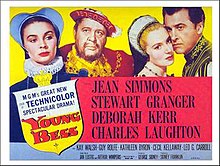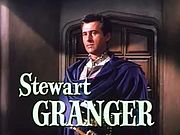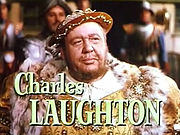The Private Life of Henry VIII is a 1933 British film directed and co-produced by Alexander Korda and starring Charles Laughton, Robert Donat, Merle Oberon and Elsa Lanchester. It was written by Lajos Bíró and Arthur Wimperis for London Film Productions, Korda's production company. The film, which focuses on the marriages of King Henry VIII of England, was a major international success, establishing Korda as a leading filmmaker and Laughton as a box-office star.

The Barretts of Wimpole Street is a 1934 American romantic drama film directed by Sidney Franklin based on the 1930 play of the same title by Rudolf Besier. It depicts the real-life romance between poets Elizabeth Barrett and Robert Browning, despite the opposition of her abusive father Edward Moulton-Barrett. The film was nominated for the Academy Award for Best Picture and Shearer was nominated for the Academy Award for Best Actress. It was written by Ernest Vajda, Claudine West, and Donald Ogden Stewart, from the successful 1930 play The Barretts of Wimpole Street by Rudolf Besier, and starring Katharine Cornell.
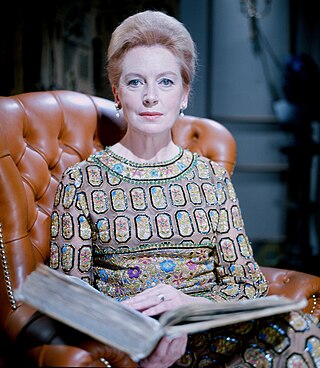
Deborah Jane Trimmer CBE, known professionally as Deborah Kerr, was a British actress. She was nominated six times for the Academy Award for Best Actress.

Thomas Seymour, 1st Baron Seymour of Sudeley, KG, PC was a brother of Jane Seymour, the third wife of King Henry VIII. With his brother, Edward Seymour, 1st Duke of Somerset and Lord Protector of England, he vied for control of their nephew, the young King Edward VI. In 1547, Seymour married Catherine Parr, the widow of Henry VIII. During his marriage to Catherine, Seymour involved the future Queen Elizabeth I, who resided in his household, in flirtatious and possibly sexual behaviour.

Jean Merilyn Simmons was a British actress and singer. One of J. Arthur Rank's "well-spoken young starlets", she appeared predominantly in films, beginning with those made in Great Britain during and after the Second World War, followed mainly by Hollywood films from 1950 onwards.

Stewart Granger was a British film actor, mainly associated with heroic and romantic leading roles. He was a popular leading man from the 1940s to the early 1960s, rising to fame through his appearances in the Gainsborough melodramas.

Green Fire is a 1954 American CinemaScope and Eastmancolor adventure drama film released by Metro-Goldwyn-Mayer. It was directed by Andrew Marton and produced by Armand Deutsch, with original music by Miklós Rózsa. The picture stars Grace Kelly, Stewart Granger, Paul Douglas and John Ericson.

Richard Thorpe was an American film director best known for his long career at Metro-Goldwyn-Mayer.
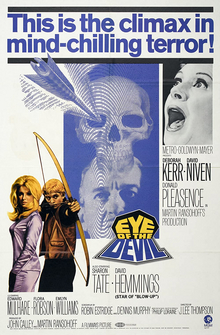
Eye of the Devil, also known by its working title 13 or Thirteen, is a 1966 British mystery horror film directed by J. Lee Thompson and starring Deborah Kerr, David Niven, Donald Pleasence, Sharon Tate and David Hemmings. Based on the 1964 novel Day of the Arrow by Robin Estridge, the movie is set in rural France. It was shot at the Château de Hautefort and in England.

Scaramouche is a 1952 romantic swashbuckler film starring Stewart Granger, Eleanor Parker, Janet Leigh, and Mel Ferrer. Filmed in Technicolor, the MGM production is loosely based on the 1921 novel Scaramouche by Rafael Sabatini as well as the 1923 film version starring Ramon Novarro. It was directed by George Sidney and produced by Carey Wilson from a screenplay by Ronald Millar and George Froeschel. The original music score was composed by Victor Young and the cinematography by Charles Rosher.
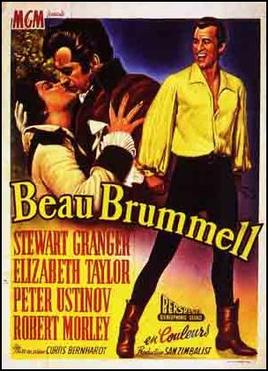
Beau Brummell is a 1954 British historical film released by Metro-Goldwyn-Mayer. It was directed by Curtis Bernhardt and produced by Sam Zimbalist from a screenplay by Karl Tunberg, based on the 1890 play Beau Brummell by Clyde Fitch. The play was previously adapted as a silent film made in 1924 and starring John Barrymore as Beau Brummell, Mary Astor, and Willard Louis as the Prince of Wales.

The Little Hut is a 1957 British romantic comedy film made by MGM starring Ava Gardner, Stewart Granger and David Niven. It was directed by Mark Robson, produced by Robson and F. Hugh Herbert, from a screenplay by Herbert, adapted by Nancy Mitford from the play La petite hutte by André Roussin.

Salome is a 1953 American drama Biblical film directed by William Dieterle and produced by Buddy Adler from a screenplay by Harry Kleiner and Jesse Lasky Jr. The music score was by George Duning, the dance music by Daniele Amfitheatrof and the cinematography by Charles Lang. Rita Hayworth's costumes were designed by Jean Louis. Hayworth's dances for this film were choreographed by Valerie Bettis. This film was the last produced by Hayworth's production company, the Beckworth Corporation.

All the Brothers Were Valiant is a 1953 Technicolor adventure drama film produced by Metro-Goldwyn-Mayer and directed by Richard Thorpe. The film's screenplay was written by Harry Brown and based on the 1919 novel All the Brothers Were Valiant by Ben Ames Williams. The music score was led by Miklós Rózsa and the cinematography by George J. Folsey.
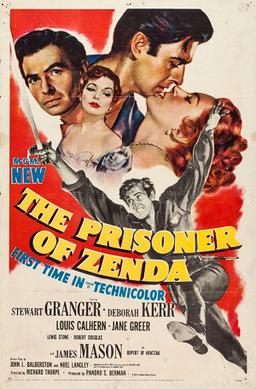
The Prisoner of Zenda is a 1952 American Technicolor adventure film version of the 1894 novel of the same name by Anthony Hope and a remake of the 1937 sound version and the 1922 silent. This first color version, made by Loew's and Metro-Goldwyn-Mayer, was directed by Richard Thorpe and produced by Pandro S. Berman. The film stars Stewart Granger, Deborah Kerr, and James Mason, with Louis Calhern, Robert Douglas, Jane Greer, and Robert Coote in supporting roles.

King Solomon's Mines is a 1950 Technicolor adventure film, and the second film adaptation of the 1885 novel of the same name by Henry Rider Haggard. It stars Deborah Kerr, Stewart Granger and Richard Carlson. It was adapted by Helen Deutsch, directed by Compton Bennett and Andrew Marton and released by Metro-Goldwyn-Mayer.

The Three Musketeers is a 1948 film directed by George Sidney, written by Robert Ardrey, and starring Gene Kelly and Lana Turner. It is a Technicolor adventure film adaptation of the classic 1844 novel The Three Musketeers by Alexandre Dumas.

The King's Thief is a 1955 swashbuckling CinemaScope adventure film directed by Robert Z. Leonard, who replaced Hugo Fregonese during filming. Released on August 5, 1955, the film takes place in London at the time of Charles II and stars Ann Blyth, Edmund Purdom, David Niven, George Sanders and Roger Moore.
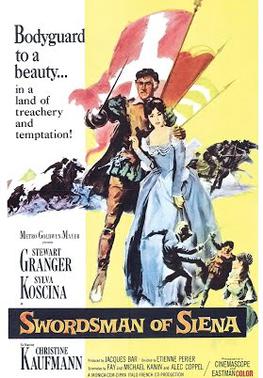
Swordsman of Siena is a 1962 French-Italian adventure film directed by Étienne Périer and Baccio Bandini and starring Stewart Granger, Sylva Koscina and Christine Kaufmann. The film is set in Spanish-controlled Italy during the sixteenth century.
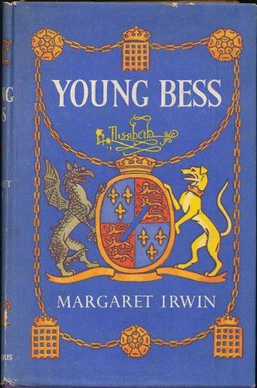
Young Bess is a 1944 historical novel by the British writer Margaret Irwin. It was the first of trilogy focusing on the life of Elizabeth I of England. It focuses on her years as a princess during the reign of her father Henry VIII. It was followed by two sequels, Elizabeth, Captive Princess (1948) and Elizabeth and the Prince of Spain (1953).
